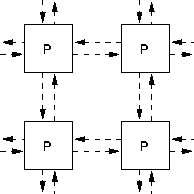
Figure 31: A 2D Processor Grid
Processors can be interconnected in a number of ways, see Figures 31 and 32:

Figure 31: A 2D Processor Grid
![]()
Figure 32: A 1D Processor Chain
Data is distributed (or `overlaid') onto the processor grids.
A more complex configuration is a hypercube. This is similar to a 2x2x2 cube except it is constructed in much more than 3 dimensions.
There are two main types of parallel computers
The former is more scalable than the latter meaning that DMMs can support more processing elements (processors).
There are also Distributed Shared Memory machines such as the IBM SP-2 and NUMA (Non-Uniform Memory Architecture) such as the KSR-1 which can loosely be described as hybrids of the main two types.
Return to corresponding overview page ![]()